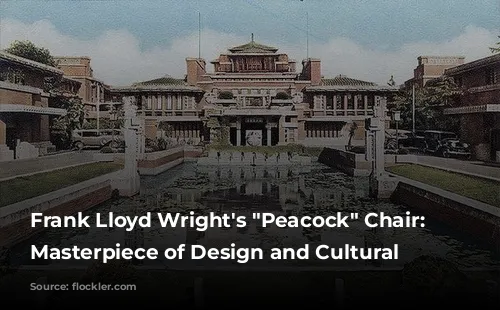This is a captivating story of how a legendary architect, Frank Lloyd Wright, created a piece of furniture that reflects his genius and embodies the cultural exchange between Japan and the West. It is a story that intertwines art, architecture, and history, and it all starts with the iconic “Peacock” chair.
Designed for the Imperial Hotel in Tokyo, this stunning chair is more than just a piece of furniture; it is a testament to Wright’s innovative approach to design and his fascination with Japanese art. The chair, crafted from oak and oil cloth, is instantly recognizable with its hexagonally shaped back, reminiscent of the hotel’s ornate cornice and ceiling. It reflects the influence of Japanese design principles on Wright’s aesthetic, demonstrating his deep appreciation for the “East.”

The Imperial Hotel: A Monument to Innovation
The Imperial Hotel was not just a building; it was a visionary project that challenged traditional architectural norms. In 1916, the Japanese government commissioned Wright to design a new hotel that would withstand the country’s frequent earthquakes. Wright’s innovative solution was to “float” the structure on concrete slabs, ensuring its stability against seismic tremors. The hotel’s opening in 1922 marked a pivotal moment in Wright’s career, signifying his departure from the “Prairie school style” and his embrace of “Organic Architecture,” where form and function are harmoniously intertwined.
A Gesamtkunstwerk: The Hotel as a Total Work of Art
The Imperial Hotel was more than just a place to stay; it was a testament to Wright’s vision of a “Gesamtkunstwerk,” or “total work of art.” From its elaborate H-shaped plan encompassing two interior gardens to the silverware in its dining room, every detail was carefully considered. Wright’s concept of decorative unity was evident throughout the hotel, and all of the interior furnishings, including the “Peacock” chair, were designed and produced specifically for the space. The chair was strategically placed throughout the building, from the parlor to the theater, serving as a beautiful and functional centerpiece.
A Fusion of Cultures: The “Peacock” Chair as a Symbol of Exchange
The “Peacock” chair’s design is a beautiful blend of Western and Eastern influences. Its hexagonal form, inspired by Japanese art and design, showcases Wright’s ability to integrate different cultural aesthetics. However, the chair’s presence in Japan also reflects the country’s desire to modernize and embrace Western influences.
In a sense, the chair stands as a symbol of the complex relationship between Japan and the West during this period, demonstrating their mutual fascination with each other’s cultures.
A Legacy Preserved: The “Peacock” Chair’s Enduring Influence
The Imperial Hotel was demolished in 1968, but its legacy lives on. The hotel’s lobby and entrance pool were preserved at the Meiji Mura Museum in Inyuama, Japan, and the furniture, including the “Peacock” chair, was dispersed to various museums and private collections.
Today, the “Peacock” chair can be found in prestigious institutions like The Museum of Modern Art in New York, The Cooper-Hewitt, National Design Museum in New York, and The Philadelphia Museum of Art.
Frank Lloyd Wright’s “Peacock” chair is more than just a piece of furniture; it is a symbol of cultural exchange, architectural innovation, and artistic genius. This iconic chair continues to inspire and captivate audiences today, serving as a testament to the enduring power of design and the enduring impact of Frank Lloyd Wright’s vision.

